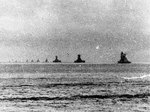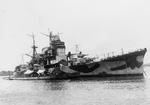Myoko
| Country | Japan |
| Ship Class | Myoko-class Heavy Cruiser |
| Builder | Yokosuka Naval Arsenal |
| Laid Down | 25 Oct 1924 |
| Launched | 16 Apr 1927 |
| Commissioned | 31 Jul 1929 |
| Decommissioned | 8 Jun 1946 |
| Displacement | 10,980 tons standard; 13,300 tons full |
| Length | 662 feet |
| Beam | 68 feet |
| Draft | 21 feet |
| Machinery | 4 geared turbines, 12 boilers |
| Power Output | 130,000 shaft horsepower |
| Speed | 36 knots |
| Range | 8,000nm at 14 knots |
| Crew | 773 |
| Armament | 10x203mm, 6x120mm (pre-1934), 8x127mm (post-1934), 2x13mm machine guns |
| Armor | 4in main belt, 1.375in main deck, 1in turrets, 3in barbettes |
| Aircraft | 2 |
Contributor: C. Peter Chen
ww2dbaseNamed after a mountain in Niigata Prefecture, Myoko was the lead ship of the four-member class of heavy cruisers. At the start of the Pacific War, she participated in the invasion of the Philippines in Dec 1941, providing cover for the landings at Davao and Legaspi. In late Dec 1941, she was reorganized, along with all other members of Cruiser Division 5, and assigned under Rear Admiral Raizo Tanaka. On 4 Jan 1942, she was attacked by American B-17 bombers, and was hit by one 500-lb bomb; she was drydocked at Sasebo for repairs. On 1 Mar 1942, she participated in the Battle of the Java Sea, sharing the credit for disabling the British destroyer Encounter that eventually led to her scuttling. In Apr 1942, she unsuccessfully gave chase to the carriers that launched the Doolittle raiders who bombed the Japanese home islands. In May 1942, Myoko was part of the escort for the Tulagi invasion force in the Battle of the Coral Sea, then in the following month she sailed with the Midway invasion force though she did not participate in combat. In late-Jun 1942, she sailed with Cruiser Division 5 to support the newly captured Aleutian Islands. On 11 Oct 1942, Myoko sailed as a part of the Second Fleet from Truk for Guadalcanal. After some time refitting at Sasebo, she returned to Guadalcanal again to assist in its evacuation. In May 1943, she assisted the evacuation of Kiska in the Aleutian Islands. In Jun 1943, she was fitted with four Type 96 25mm anti-aircraft gun mounts and a Type 21 air search radar set; the work was completed at Sasebo. In Nov 1943, she sailed under the banner of Cruiser Division 5 as escorts for four destroyer transports carrying 1,000 troops for Bougainville. The fleet made contact with an American force, and the Battle of Empress Augusta Bay ensued. At the conclusion of the battle, the Japanese scored a victory, but Myoko suffered some damage as the result of a collision with destroyer Hatsukaze; Hatsukaze was seriously damaged and was eventually sunk at the end of the battle. On 17 Nov, she arrived at Sasebo and received eight single-mount 25mm anti-aircraft guns, then acted as convoy escorts in the Truk-Palau area until May 1944. In Jun 1944, she participated in the Battle of the Philippine Sea. Later in the war, she acted as a floating battery at Singapore. After the war, she was scuttled off Port Swettenham, Malaya.
ww2dbaseSource: Wikipedia.
Last Major Revision: Mar 2007
Heavy Cruiser Myoko Interactive Map
Photographs
 |  |  |  |
Myoko Operational Timeline
| 31 Jul 1929 | Myoko was commissioned into service. |
| 1 Nov 1929 | Captain Yoshiyuki Niiyama, commanding officer of Nachi, took on a dual role as the commanding officer of cruiser Myoko. |
| 22 May 1939 | Myoko, flagship of Vice Admiral Koichi Shiozawa of Japanese Navy 5th Fleet, arrived in Xiamen, China in response to recent British, French, and American troop arrivals in the international zone. |
| 8 May 1942 | Japanese and US carrier fleets at Coral Sea discovered each other in the morning, each closing in to attack. Japanese carrier Shokaku was damaged by 3 bombs at 1057 hours (223 casualties), while American carrier USS Lexington was hit by two bombs at 1120 hours (191 killed at 1120 hours; gasoline explosion at 1247 hours killed another 25; scuttled by USS Phelps at 1915 hours) and American carrier USS Yorktown was hit by a bomb (66 casualties). Meanwhile at Port Moresby, an Australian cruiser force successfully defended itself against land-based aircraft attack as it blocked the Japanese invasion fleet for Port Moresby, New Guinea. As both sides withdrew due to damage and losses, the Japanese scored a tactical victory, but lost strategic momentum as the Port Moresby invasion must now be delayed. |
| 4 Nov 1942 | Zuikaku, Myoko, Hatsukaze, and Tokitsukaze departed Truk, Caroline Islands. |
| 9 Nov 1942 | Zuikaku, Myoko, Hatsukaze, and Tokitsukaze arrived at Kure, Japan. |
| 8 May 1943 | Yamato, Chuyo, Unyo, Myoko, Haguro, Yugure, Naganami, Samidare, and Ushio departed Truk, Caroline Islands. |
| 13 May 1943 | Yamato, Chuyo, Unyo, Myoko, Haguro, Yugure, Naganami, Samidare, and Ushio arrived at Yokosuka, Japan. Later on the same day, Yamato departed for Kure, Japan. |
| 18 Sep 1943 | Yamato, Nagato, Shokaku, Zuikaku, Takao, Atago, Myoko, Haguro, and a destroyer screen sortied from Truk, Caroline Islands to Brown Island (Eniwetok), Marshall Islands with Combined Fleet under Vice Admiral Jisaburo Ozawa's tactical command in response to the US Task Force 15 carrier raids on Tarawa and Makin. |
| 13 Jun 1944 | Shokaku, Zuikaku, Taiho, Ryuho, Haguro, Myoko, Yahagi, Asagumo, Isokaze, Urakaze, Hatsuzuki, Wakazuki, Akizuki, and Shimotsuki departed Tawi-Tawi, Philippines toward Saipan, Mariana Islands in anticipation of an American attack. At 1830 hours, Japanese Combined Fleet leadership ordered the preparation of A-Go Operation. |
| 14 Jun 1944 | Shokaku, Zuikaku, Taiho, Ryuho, Haguro, Myoko, Yahagi, Asagumo, Isokaze, Urakaze, Hatsuzuki, Wakazuki, Akizuki, and Shimotsuki arrived at Guimaras island, Philippines in the afteroon. |
| 15 Jun 1944 | The Japanese Combined Fleet activated A-Go Operation at 0717 hours as the Americans commenced their invasion of Saipan, Mariana Islands. At 0800 hours, Shokaku, Zuikaku, Taiho, Ryuho, Haguro, Myoko, Yahagi, Asagumo, Isokaze, Urakaze, Hatsuzuki, Wakazuki, Akizuki, and Shimotsuki departed Guimaras Island, Philippines toward Saipan, passing through San Bernardino Strait at 1730 hours. |
| 16 Jun 1944 | Shokaku, Zuikaku, Taiho, Ryuho, Haguro, Myoko, Yahagi, Asagumo, Isokaze, Urakaze, Hatsuzuki, Wakazuki, Akizuki, and Shimotsuki commenced refueling operations in Philippine waters. |
| 17 Jun 1944 | Shokaku, Zuikaku, Taiho, Ryuho, Haguro, Myoko, Yahagi, Asagumo, Isokaze, Urakaze, Hatsuzuki, Wakazuki, Akizuki, and Shimotsuki departed Philippine waters ad sailed toward Saipan, Mariana Islands at 1530 hours. At 2015 hours, USS Cavalla made radar contact with the Japanese carrier fleet in the Philippine Sea; Commander Herman Kossler decided to sail away in order to surface later, at 2245 hours, to send the contact report to his superiors. Receiving this news, US Navy leadership ordered search planes to be sent to look for this carrier fleet, thus setting up for the subsequent Battle of the Philippine Sea. |
| 20 Jun 1944 | At 1130 hours, the Japanese Mobile Fleet, withdrawing west from the losses sustained on the previous day during the Battle of the Philippine Sea, paused to refuel from tankers while Vice Admiral Jisaburo Ozawa transferred his flag aboard Zuikaku. At 1500 hours, cruiser Atago reported seeing an American scout plane, and Ozawa ordered the refueling to be stopped and the fleet was to sail to the northwest at the speed of 24 knots. At 1725 hours, a large incoming American strike was detected. The Japanese mustered 17 fighters for defense, while the Haguro, Myoko, Yahagi, and seven destroyers formed a tight circle around Zuikaku. 95 American fighters, 54 torpedo bombers (most of which were armed with bombs rather than torpedoes), and 77 dive bombers from USS Hornet, USS Yorktown, and USS Belleau Wood arrived at 1730 hours, hitting Zuikaku once with a bomb, causing some damage. |
| 8 Jun 1946 | Myoko was decommissioned from service. |
Please consider supporting us on Patreon. Even $1 per month will go a long way! Thank you. Please help us spread the word: Stay updated with WW2DB: |

» Omori, Sentaro
Event(s) Participated:
» Battle of Xiamen
» Guangdong Operation
» Battle of Hainan
» Invasion of the Philippine Islands
» Dutch East Indies Campaign, Java
» Battle of Coral Sea
» Battle of Midway and the Aleutian Islands
» Guadalcanal Campaign
» Solomon Islands Campaign
» Mariana Islands Campaign
Partner Sites Content:
» Myoko Tabular Record of Movement
- » 1,175 biographies
- » 337 events
- » 44,927 timeline entries
- » 1,245 ships
- » 350 aircraft models
- » 207 vehicle models
- » 376 weapon models
- » 123 historical documents
- » 261 facilities
- » 470 book reviews
- » 28,465 photos
- » 365 maps
Winston Churchill, 1935
Please consider supporting us on Patreon. Even $1 a month will go a long way. Thank you!
Or, please support us by purchasing some WW2DB merchandise at TeeSpring, Thank you!


















